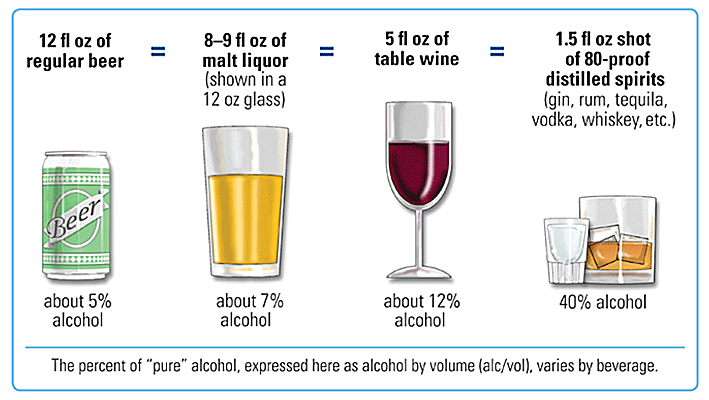Drinking Levels DefinedWhat Is A Standard Drink?
Many people are surprised to learn what counts as a drink. The amount of liquid in your glass, can, or bottle does not necessarily match up to how much alcohol is actually in your drink. Different types of beer, wine, or malt liquor can have very different amounts of alcohol content. For example, many light beers have almost as much alcohol as regular beer – about 85% as much. Here’s another way to put it:
That’s why it’s important to know how much alcohol your drink contains. In the United States, one "standard" drink contains roughly 14 grams of pure alcohol, which is found in:

Even though they come in different sizes, the drinks below are each examples of one standard drink:
The same amount of alcohol is contained in 12 fluid ounces of regular beer, 8 to 9 fluid ounces of malt liquor, 5 fluid ounces of table wine, or a 1.5 fluid ounce shot of 80-proof spirits (“hard liquor” such as whiskey, gin, etc.) The percent of ‘pure’ alcohol varies by beverage.
The percent of “pure” alcohol, expressed here as alcohol by volume (alc/vol), varies by beverage.
Although the “standard” drink amounts are helpful for following health guidelines, they may not reflect customary serving sizes. In addition, while the alcohol concentrations listed are “typical,” there is considerable variability in alcohol content within each type of beverage (e.g., beer, wine, distilled spirits).
Drinking Levels Defined
Moderate alcohol consumption:
According to the Dietary Guidelines for Americans, moderate drinking is up to 1 drink per day for women and up to 2 drinks per day for men.
Binge Drinking:
NIAAA defines binge drinking as a pattern of drinking that brings blood alcohol concentration (BAC) levels to 0.08 g/dL. This typically occurs after 4 drinks for women and 5 drinks for men—in about 2 hours.
The Substance Abuse and Mental Health Services Administration (SAMHSA), which conducts the annual National Survey on Drug Use and Health (NSDUH), defines binge drinking as drinking 5 or more alcoholic drinks on the same occasion on at least 1 day in the past 30 days.
Heavy Drinking:
SAMHSA defines heavy drinking as drinking 5 or more drinks on the same occasion on each of 5 or more days in the past 30 days.
Low Risk for Developing an Alcohol Use Disorder (AUD):
As defined by NIAAA, for women, low-risk drinking is no more than 3 drinks on any single day and no more than 7 drinks per week. For men, it is defined as no more than 4 drinks on any single day and no more than 14 drinks per week. NIAAA research shows that only about 2 in 100 people who drink within these limits have an AUD. Even within these limits, you can have problems if you drink too quickly or have other health issues.